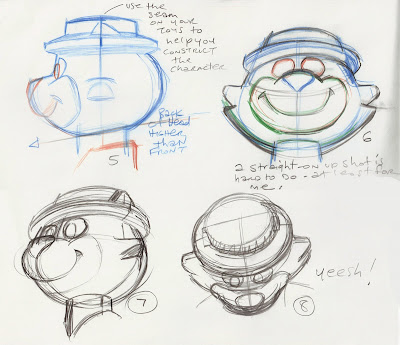
Toys are Better Than Life Drawing for Cartoon Construction Studies
Life drawing in theory can be useful to an animator. It can teach you perspective and construction, foreshortening and the like, but in reality, it's very hard to look at very complicated structures of human beings and break them down into fundamentals you can use for cartoon shapes.You get too easily distracted and confused by the tons of details on real live creatures. You can't see the underlying forms easily.
Most cartoons don't show any important influence from life drawing anyway. Even the ones that are supposed to be "realistic". They suffer from the confusion between detail and form. Form is more important than detail.
I'd put some examples up, but some folks will freak out.
The details need to follow the physics of the forms, and the more detailed your cartoon design is, the harder it is to control - especially if the underlying form is faulty to begin with.
 Drawing well sculptured toys makes the fundamentals of construction and perspective much easier to grasp, and just as importantly to then be able to instantly apply them to your cartoon drawings.
Drawing well sculptured toys makes the fundamentals of construction and perspective much easier to grasp, and just as importantly to then be able to instantly apply them to your cartoon drawings.

When you turn a toy around, you can see how the features change shape as they bend around the curved surfaces.
 If the head tilts up, then the features that stick out (noses) start to obscure the features above. You see more of the underside of the form than the top. This may sound obvious, but try to draw it!
If the head tilts up, then the features that stick out (noses) start to obscure the features above. You see more of the underside of the form than the top. This may sound obvious, but try to draw it!




Construction is not something that comes natural to me. I naturally draw "by design", that is to just put shapes that balance well together in 2 dimensions. That's a fault, because it doesn't mean the characters will turn well when animated.
Some folks have a natural eye (or brain) for construction - like Jim Smith, who just somehow sees the structure of something instantly. I see the details first and have to force myself to think about forms. (Squinting your eyes helps blur details and allows you to see the underlying structures better)
When I draw toys, it helps me to get more used to the logic of structures in space. If I did it a lot, it would start to become second nature and I wouldn't have to think about it so much.
Today, when almost everybody draws ridiculously flat, real animation can't even exist. We have to rely on silly tricks to zip characters from one abstract flat pose to the next. This severely limits what we can achieve creatively.
WHEN YOU COPY, DRAW SLOW, CAREFUL AND THINK

 Note on the 3/4 poses, the feet have no perspective...(except for that pink stumpy thing on the right)
Note on the 3/4 poses, the feet have no perspective...(except for that pink stumpy thing on the right)


 Note on the 3/4 poses, the feet have no perspective...(except for that pink stumpy thing on the right)
Note on the 3/4 poses, the feet have no perspective...(except for that pink stumpy thing on the right)When you copy something, there is a purpose to it: to learn something. If you draw too fast, you will not learn anything.
You want to carefully study your model.
When I am learning something, I tend to draw stiff, because I am thinking about what I am trying to learn. The drawings don't come out all pretty with clean flowing lines and stuff.
When you study, you are trying to be accurate, as opposed to beautiful and flowing.
Once you have done your stiff drawings, you can loosen up a bit and then try again from memory and see if what you learned sunk in.

I did this quick sketch at a pizza joint a couple days after my Top Cat study. It's a little wonky, but some of what I sketched slowly 2 days earlier sunk in.
If you also start to study and you draw slowly and carefully, and critique your own studies honestly, then you will absorb much information that later you can apply to your own work.
If you want to learn construction well, this is a very good exercise. Draw toys. You can draw the same angles that I did above and compare them to mine, then try these new angles below.
If you want me to critique them, put links in the comments to your drawings.
 You can also take your drawings into Photoshop along with the photos and lay them on top of each other at a % to check how accurate your copies are.
You can also take your drawings into Photoshop along with the photos and lay them on top of each other at a % to check how accurate your copies are.

 See, Kali is doing it:
See, Kali is doing it:
http://kalikazoo.blogspot.com/2007/09/muskie-soaky.html